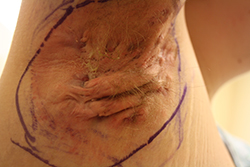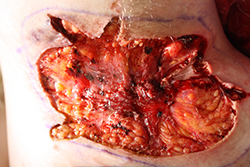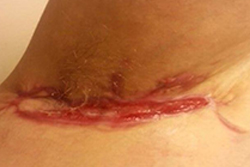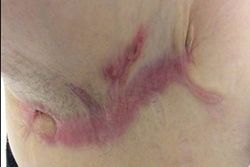CO2 Laser Surgical Excision for Hidradenitis Suppurativa
Dr. Hamzavi and the faculty at Henry Ford Dermatology offers CO2 Laser Surgical Excision for Hidradenitis Suppurativa, a relatively novel and successful treatment in eradicating significantly scarred and persistent HS.
The Science behind CO2 Laser Surgical Excision
How it Works
CO2 laser treatment targets the sweat glands and hair follicles that are responsible for hidradenitis suppurativa. The laser destroys these cells and stimulates new collagen growth, which leads to the healing process.
Benefits of CO2 Laser Treatment
- Minimal recovery time
- Reduced risk of infection
- Low rate of recurrence at site
- Hazen PG, Hazen BP. Hidradenitis suppurativa: successful treatment using carbon dioxide laser excision and marsupialization. Dermatol Surg. 2010;36(2):208-213. doi:10.1111/j.1524-4725.2009.01427.x
- Ezekwe N, Neelam R, Jones BA, Ozog DM, Hamzavi IH. Retrospective study of keloid formation after CO2 excision therapy for hidradenitis suppurativa. J Am Acad Dermatol. 2023;89(1):181-182. doi:10.1016/j.jaad.2023.03.001
- Reduced bleeding risk compared to traditional surgery
Who is a Good Candidate?
CO2 laser treatment is suitable for people with stage II-III (scar tissue and sinus tracts) of hidradenitis suppurativa. It is best for individuals who have not responded well to other treatments such as antibiotics, corticosteroid injections, and surgery.
Tumescent anesthesia
We utilized tumescent anesthesia to numb the area of HS we plan to excise with the CO2 laser. This allows for:
- larger treatment areas compared to traditional excision
- greater pain control
- reduced bleeding risk
- no need for general anesthesia
CO2 Laser Excision vs. Other Treatments
Traditional Surgery
Traditional surgical excision involves removing affected areas of the skin in a deroofing or excision. This treatment can be successful in severe cases, but it has a higher risk of recurrence compared to CO2 laser excision and longer recovery times. Also a larger area may require undergoing general anesthesia while CO2 excision is an outpatient procedure with light sedation.
Corticosteroid Injections
Corticosteroid injections can help reduce inflammation and swelling, but the effects are often temporary. Steroid injections also do not treat sinus tracts and scarring.
Antibiotics
Antibiotics can be effective in treating hidradenitis suppurativa, but they should be used cautiously to prevent the development of antibiotic-resistant bacteria. Antibiotics can be used as a bridge to surgery at times to help with inflammation.
Biologic Medications
Biologic medications such as adalimumab, infliximab, secukinmab, ustekinumab all work by targeting specific pathways and molecules that are implicated in HS. These medications are important in reducing levels of inflammation and HS disease activity overall but may not work for everyone. Importantly, they will not reverse any scarring or sinus tunnels that have already formed.
Alternative Medicine and Diet
Lifestyle modifications such as weight loss and quitting smoking have been recommended to help with HS. Eliminating dairy may help some patients with HS and having a low glycemic diet may also improvement HS. Eliminating wheat and brewer's yeast has also helped some patients. Supplements such as Curcumin, vitamin D, and Zinc may be beneficial. Evidence is mixed but may be helpful to some patients.
Silfvast-Kaiser A, Youssef R, Paek SY. Diet in hidradenitis suppurativa: a review of published and lay literature. Int J Dermatol. 2019;58(11):1225-1230. doi:10.1111/ijd.14465.
Results Following CO2 Laser Excision of HS in the Underarm
Preparation for the Procedure
Before the Treatment
Before you undergo CO2 laser treatment, you will need to avoid certain medications such as aspirin, ibuprofen, and blood thinners. You must have a driver the day of surgery, assistance with wound care, and dressing supplies. Please let your care team know if you have any drug allergies.
Day of the Procedure
Arrive promptly at 8am. Remember to pick up your medications from the pharmacy. Eat a healthy breakfast before you come in. Wear comfortable, loose-fitting clothing. You can bring headphones to listen to music during the surgery if you would like.
During the procedure
There will be ultrasound imaging performed of the area first. You will be given oral medication to relax and reduce discomfort. The laser procedure typically takes between 30-60 minutes and is performed under local anesthesia. The laser is applied over the affected area, and you may feel a warm sensation on your skin.
After the procedure
After the treatment, you may experience some redness, swelling, and mild discomfort. Your doctor may prescribe pain medication and topical antibiotics to prevent infection. It is important to follow your doctor's instructions carefully to ensure proper healing. The dedicated HS wound care nurses will go over specific instructions and dressings for your wound.
What to Expect during Recovery
Your Wound
You will be asked to look at your wound for the 1st time after surgery. This will allow you to ask questions and to understand the appropriate appearance of your wound. Your wound will appear graphic and may be disturbing for you to see. Please be assured that each individual response to seeing your wound is normal and understandable.
Healing Process
Our team will go over specific wound care instructions to keep the wound moist. Your dressings will stay in place until you return for a 24 hour follow up. It is recommended to follow up based on the schedule given to you by your care team. The wound diameter should reduce in size by 25% every 2 weeks. Most patients within 12 weeks, but some patients may take up to 6 months to heal. Patients will find that they feel a dramatic improvement from their pain and drainage from their HS within 2 weeks after surgery.
Potential Side Effects
Although rare, side effects can occur after the treatment, including hyperpigmentation, hypopigmentation, and scarring. If the area of HS is in the underarm, it is important to begin range of motion exercises when directed to make sure the skin heals properly to prevent any excessive contraction.
Diet
While in the wound healing process, it is important to consume extra protein, about 1.5 grams of protein per kilogram per day, to encourage the body to create new tissue to heal.
Controlling Comorbidities
While healing, if you have diabetes, it is important to make sure your blood sugars are well controlled to help the body heal as fast as it can.
Moisture Balance
During your visits you will receive teaching from our team about wound care for your surgical wound. It is important to keep the wound bed moist with petrolatum and then to slowly decrease the amount as the wound begins to heal.
FAQs
-
How Long Does the Procedure Take?The procedure usually takes between 30-60 minutes, depending on the size and severity of the affected area. You will spend approximately half the day in the clinic. Someone must drive you to the appointment as there are preoperative medications to aid with pain and anxiety.
-
Is CO2 Laser Treatment Painful?The procedure is performed under local anesthesia, so you should not experience any pain during the treatment. You may feel some heat and tugging during the procedure. Interestingly, the majority of our patients report that their postsurgical pain is less than their pain from their HS.
-
What are my chances of my HS coming back after CO2 Surgery?Our data shows that you have approximately a 90% chance of not requiring additional surgery at the location of the site. You may still require other medical and surgical treatments for HS on other parts of your body.
-
How large will my wound be?Since we are unable to know the exact number or length of sinus tracts in your surgical area, it is not possible for us to know ahead of time exactly how large your wound will be. We can only estimate. We utilize ultrasound to visualize tracts which may run deeper than what we can see by our visual exam.
.svg?iar=0&hash=F6049510E33E4E6D8196C26CCC0A64A4)

/hfh-logo-main--white.svg?iar=0&hash=ED491CBFADFB7670FAE94559C98D7798)



